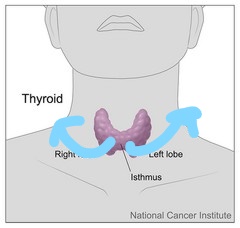Pain is complex. If pain was simple, our country would not be in an opioid epidemic with pain addiction being on the rise. When you add hormones to the holistic big picture, it truly makes a medical practitioner have to look at you as an individual to make the best choice for you. Our saying is that your body works together, heals together. In our world, your thyroid and associated organs are more important for your survival and will sacrifice your neck joints and muscles to make you notice. How to tell if you have thyroid problems related with your neck pain?
Wait… back up a bit. Why is a Physical Therapist interested in the thyroid gland for rehabilitating an injury?
Our goal is to get you to have mobility and strong so you can stay active. If you feel sluggish, this is a whole-body phenomenon that includes weakening of your neck and trunk musculatures. Unhealthy musculature support means more pressure on your neck joints.
In addition, your body is good at doing what is best to help you to survive.
If your body needs to supply more circulation to your thyroid gland to maintain a certain level of health to the thyroid gland, your body will not hesitate to take the blood supply from your neighboring neck muscles and joints.
So how to tell if you have a thyroid problem related with your neck pain?
THREE FACTORS WE USE TO ACCESS IF YOU HAVE A FUNCTIONAL THYROID.
You can have a normal thyroid “test” and still have an issue with the thyroid gland that is undetected. We use three processes to help us determine what is the best treatment for you. Doctor of Physical Therapy are trained to understand diagnostic tests and lab work for a hospital-based setting but many Sports Medicine Long Beach Physical Therapy clinics forget the value when applying it to their patients like you.
Did you know that an estimated 20 million Americans have some form of thyroid disease? One in eight women will develop a thyroid disorder during her lifetime. And, the number of people suffering from thyroid disorders continues to rise each year and many walk around undetected as you will read below.
The three factors we look at to help your neck pain with a thyroid component are listening and emphasizing on the LOST art of listening, lab work, and Visceral Manipulation principles. We will explain how all 3 are applied at our clinic so you can help yourself.
Humans are not robots but insurance-dictated Western Medicine forces Doctors to rely on tests to help us make a decision in a fast-paced environment. Trouble happens when you make a snap decision from one factor. This is called making a medical “judgment” or impression. How many times have we been wrong when we rely on our first impression? Dating? When our children fight and you end up punishing the wrong child. Snap judgment is why knee, back, heart stents, and shoulder arthroscopy are only 50% successful. Medical Doctors sacrifice precision to save time at the clinic.
This is a big reason to use the correct tests as part of a big picture medical decision making… so should you when trying to understand what you are dealing with.
What are common hypothyroidism symptoms that you should not ignore?
Hypothyroidism symptoms you might be feeling include weight gain, hair loss, exhaustion, constipation, depression, or mental fog.
What happens when your thyroid tests are NORMAL but you sense something is still “off”?
There are two common tests that Physicians will use to make a decision. Thyroid Stimulating Hormone and Total T4.
Thyroid Stimulating Hormone (TSH) is produced by the pituitary gland. TSH is the signal that the pituitary gland makes to tell the thyroid gland how much thyroid hormone to make. TSH is the most sensitive marker to help determine hypothyroidism and hyperthyroidism. If the thyroid gland is not getting told to produce T4 hormone then you will need to look at a possible dysfunctional pituitary gland located near the brain.
High cortisol, or stress hormone, can weaken the pituitary gland to not make enough signal for the thyroid gland to function well. High cortisol can come from active infection, blood sugar imbalances, chronic stress, pregnancy, hypoglycemia or insulin resistance.
The thyroid gland produces ~92% of the T4 hormone and remaining ~8% is the T3 hormone. T4 gives you an idea of how the thyroid is functioning but can be misleading when used alone.
What is better to look at is total T3 since it is the more active metabolic hormone and responsible for what your thyroid gland is doing to the whole body. Total T3 levels give you an insight into how much T4 is being converted to T3 within the liver, gut, and peripheral tissues. If you have thyroid symptoms but have “normal” T4 and TSH level and low T3, the root cause is coming from a dysfunctional state to the liver, digestive system or cell membranes of the peripheral tissues. The T4 to T3 change is impacted when there are inflammatory cytokines attacking the cell membranes. High cortisol can suppress the T4 to T3 conversion, along with the above mentioned TSH production. Basically, investigative away from the thyroid gland might help you get better.
To complicate the matter more, looking at free T4 or free T3 can be helpful.
A hormone is fat soluble and not water soluble. What this means is that all hormone, including T4 and T3, cannot be moved in the bloodstream since blood is composed of water. Hormones need protein carrier such as Thyroid-binding globulin (TBG) to bring T4 or T3 to the cellular receptor destination. The thyroid gland hormones become “active” and ready to be used when T4 or T3 gets cut from the TBG. The metabolic active thyroid hormones become free T4 or free T3.
Here is another scenario where you can have a “normal” thyroid panel of total T3, total T4, and TSH, but not understand that your thyroid symptoms are due to the lack of thyroid hormones shuttling to where the thyroid hormones are used by your body. A low protein carrier TBG indicates this high total but low free T3 and T4 resulting in hypothyroidism. A reason for hypothyroidism when you see low free thyroid hormones is from too much estrogen. Hyperthyroidism with a higher free T3 and T4 can be from not having enough protein carrier.
Lastly, a complete lab panel will include thyroid gland antibodies (TGA) to see if your immune system is weak or compromised. When the body attacks the thyroid gland, this is called Hashimoto’s Disease. This disease is the most common cause of thyroid low function in the modern world. Thyroid gland antibodies are rarely tested since Western Medicine treatment protocol does not change, so why test for thyroid gland antibodies. Hashimoto’s Disease is not serious to need steroids so Medical Doctors have no value in knowing if the poor and low function of the thyroid is due to an immune weakening issue. A positive TGA lets you know that you may need to address the immune system.
Just in case, antibodies are proteins that your immune cells make to fight off bacteria, viruses, and other harmful invaders. The immunoglobulin test can show whether there’s a problem with your immune system.
A standard range of normal TSH is 0.5-4.5 but recent studies have shown that 0.5-2.25 or 2.5, depending on what recent studies you are referencing. An updated reference level of 2..25-4.5 is indicative of mild hypothyroidism.
As we try to understand the holistic nature of your body, we understand that TSH is a victim of the hypothalamus. The hypothalamus is part of the brain and makes Thyrotropin-releasing hormone (TRH). TRH bosses the pituitary on how much TSH to make, which controls the thyroid gland’s T4 production. If you have a low TRH production, you might have central hypothyroidism or non-thyroidal illness syndrome. The possible root cause of having the central version include leptin resistance, insulin resistance, inflammation, and other non-thyroid-related causes.
FYI… since you have read this far, you must be fascinated by the thyroid. Here is another common question.
What is a goiter?
Number one condition to cause goiter in the modern world is Hashimoto’s Disease. The number two reason is low iodine levels.
To make matter more tricky is that a research article has shown that ~20-30% can have a negative Thyroid gland antibodies and have a goiter. You can have Hashimoto’s Disease based on the fact that you have a goiter. A plausible explanation of having no antibodies upon testing is that some cases have a compromised TH2 antibody humeral immune system and can be tested by total Immunoglobulin level of IG-G, IG-A, IG-M, and IG-E.
Iodine is the backbone of thyroid hormones. Lacking iodine is the number one cause of having poor thyroid function in the developing world. Iodine deficiency is getting better as salt has been added with iodine, however, if you avoid iodine salts and replace it with sea salts, you risk not having enough iodine. Sea salts are our preferred choice due to the added minerals and nutrients for our nerves and organ functions.
Diary has iodine but not via natural reasons. The tanks used in dairy manufacturing is cleaned with iodine substances. Sea vegetables and white fish like cod are our preferred methods to get iodine.
With that being said, you may have a functioning thyroid (and pituitary gland) with all lab work coming back negative and still have thyroid symptoms. This scenario is due to a possible thyroid hormone resistance. The cells cannot get the hormones due to possible high cortisol and high-stress cause factor. Moral of the story, modern lifestyle can be blamed for the high rise of hypothyroidism diagnosis. You do not have to be a victim of this if you know how to bring a mind and body system to yourself.
What can you do to help your thyroid gland (this also applies if you had your thyroid removed)?
The beauty of visceral manipulation is that we can add another level of assessment and treatment to ensure you help you to have more energy, concentration, healthy hair and weight management. To keep it short, every organ is suspended and surrounded by the fascial system. Again, think the thin film when you prepare chicken for dinner. That thin film that is in between the skin and muscles. If you look carefully, you can see that it dives in between muscles and into the chicken’s organs.
As we have practiced 1000’s of hours to feel the small changes in muscle fibers and joint tension, we can feel how well each organ and associated fluids move and “breath”. Every organ moves 1-8 cm up and down when we breathe. The organ beats like a heart and lung beats. Why can’t a thyroid gland beat?
An organ beat is called motility. An organ’s amount of movement is called mobility. We use this information to determine if this matches up with your lab testing, signs, and symptoms. Everything in medicine needs to make sense. When we detect a sluggish or frozen thyroid gland, we restore this motion.
The picture shows the path the thyroid gland moves. Up and out towards your ear and back.
There are two sayings that go “motion is lotion” and “use it or lose it”. Your body is wise and is design to protect you from harming it. Your thyroid will stiffen up your neck musculatures and associated fascia in attempt to self-heal the thyroid gland. Your body will shift the amount of blood flow from your muscles towards your dysfunctional gland or organ. Unfortunately, this can be a vicious cycle of less mobility leading to less blood flow and oxygen, resulting in making your thyroid gland more sluggish. Pain has been associated with less blood flow and oxygen to the muscle tissues. Pain hurts and can falsely reinforce us not to move, which feeds into the sluggish thyroid into a frozen thyroid. Sprinkle in stress. Add a dash of processed food and sugar. Ice this situation with lack of dreaming and deep sleep.
In another article, we talked about the ability to address the pituitary glad directly by manipulating the sphenoid bone directly. Other orthopedic structures that have a direct relationship with the thyroid gland include the hyoid bone, jaw, shoulder blade and the numerous muscles and fascia that connect them. Hopefully you realize there is truly more than one or two ways to skin your thyroid or neck pain. =)
Magic… you have a confused situation that feels hopeless and frustrating. Many give in and toss the towels to accept the diagnosis of hypothyroidism and neck pain.
As a Holistic Physical Therapist, we focus on breaking this cycle on from the outside-in and inside-out approach. Get your neck moving more and easier so the mobility nourishes your thyroid gland, nerves, and fascia. We do not stop there and cross our fingers hoping things settle. We address the circulation directly to the thyroid and restore the thyroid gland fascia “organ” beat and mobility.
If you need a second medical opinion on your neck pain or this article resonated with what you are going through, you can save a spot on our schedule for a complimentary Telehealth consultation with Dr. Ngo.
One LOVE,
Dr Danh Ngo
Board Certified Orthopedic and Sports Medicine Specialist
Doctor of Holistic Physical Therapy
Mind: Body Health Results Coach
ReVITALize Rehab Club


